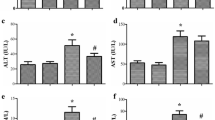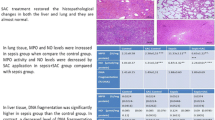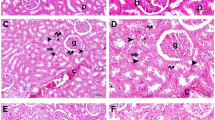Summary
The protective effects of diallyl trisulfide on liver were examined in rats with sepsis. Sepsis was reproduced in rats by cecum ligation and puncture (CLP). Fifty-six male Wistar rats were randomly divided into sham-operated group (group S, n=8), sepsis model group (group C, n=24), diallyl trisulfide (DATS)-treated group (group D, n=24). Animals in groups C and D were further divided into three subgroups according to different observation time points, with 8 rats in each subgroup· Rats in group D and C were intravenously injected with normal saline or DATS respectively at a dose of 20 mg/kg after the establishment of sepsis model. Eight rats in groups C and D were sacrificed at 3, 6 and 24 h post-CLP and their livers were harvested for detection of interleukin (IL)-1 receptor associated kinase-4 (IRAK-4), nuclear factor-κB (NF-κB), c-fos, c-jun, malondialdehydethhe (MDA) and superoxide dismutase (SOD), tumor necrosis factor alpha (TNF-α) and for pathological examination. The results showed that the levels of serum IRAK-4, NF-κB and TNF-α in hepatic tissues were higher in group C than group S (control group) (P<0.05). After DATS treatment, the levels of IRAK-4 and NF-κB in the hepatic tissues and serum TNF-α in group D were lower than those in group C (P<0.05). The levels of c-fos and c-jun and MDA in the hepatic tissues were higher in group C than in group S (P<0.05). After DATS treatment, the levels of c-fos and c-jun and MDA in the hepatic tissues were significantly lower in group D than in group C (P<0.05). When compared with group S group, concentration of SOD in the hepatic tissues in group C was significantly lower (P<0.05). After DATS treatment, the concentration of SOD in the hepatic tissues was higher in group D than in group C (P<0.05). These findings suggested that treatment with DATS could ameliorate sepsis-induced liver injury in rats. The protective effect might be related to its ability to inhibit the signal pathway of IRAK-4 and NF-κB, thereby decreasing the production of oxygen free radicals and down-regulating the expression of c-fos and c-jun.
Similar content being viewed by others
References
Zhang LT, Yao YM, Lu JQ, et al. Sodium butyrate prevents lethality of severe sepsis in rats. Sodium butyrate prevents lethality of severe sepsis in rats. Shock, 2007,27(6): 672–677
Minter RM, Bi X, Ben-Josef G, et al. LPS-binding protein mediates LPS-induced liver injury and mortality in the setting of biliary obstruction. Am J Physiol Gastrointest Liver Physiol, 2009,296(1):G45–G54
Wang YY, Ryg U, Dahle MK, et al. Liver X receptor protects against liver injury in sepsis caused by rodent ce cal ligation and puncture. Surg Infect (larchmt), 2011,12(4):283–289
Suzuki N, Suzuki S, Eriksson U, et al. IL-1R-associated kinase 4 is required for lipopolysaccharideinduced activation of APC. J Immunol, 2003,171(11):6065–6071
Xiong Y, Qiu F, Piao W, et al. Endotoxin Tolerance Impairs IL-1 Receptor-Associated Kinase (IRAK) 4 and TGF-β-activated Kinase1Activation, K63-linked Polyubiquitination and Assembly of IRAK1, TNF Receptor-associated Factor 6, and IκB Kinase γ and Increases A20 Expression. J Biol Chem, 2011,286(10):7905–7916
Van Bruggen R, Drewniak A, Tool AT, et al. Toll-like receptor responses in IRAK-4-deficient Neutrophil. J Innate Immun, 2010,2(3):280–287
Song KW, Talamas FX, Suttmann RT, et al. The kinase activities of interleukin-1 receptor associated kinase (IRAK)-1 and 4 are redundant in the control of inflammatory cytokine expression in human cells. Mol Immunol, 2009,46(7):1458–1466
McDonald DR, Goldman F, Gomez-Duarte OD, et al. Interleukin-1 Receptor-Associated Kinase 4 is Essential for Initial Host Control of Brucella abortus Infection. J Allergy Clin Immunol, 2010,126(2):332–337
Hu ZH, Wang LL, Tang QQ, et al. NF-κB levels in the liver of young rats with endotoxemic liver injury. Chongguo Dang Dai Yi Xue (Chinese), 2010,12(10):804–808
Bao S, Liu MJ, Lee B, et al. Zinc modulates the innate immune response in vivo to polymicrobial sepsis through regulation of NF-kappaB. AM J Physiol Lung Cell Mol Physiol, 2010,298(6):744–754
Ronco MT, Manarin R, Francés D, et al. Benznidazole treatment attenuates liver NF-κB activity and MAPK in a cecal ligation and puncture model of sepsis. Mol Immunol, 2011,48(6):867–873
Li J, Lai X, Chen Y, et al. Endotoxin tolerance attenuates liver ischemia/reperfusion injury by down-regulation of interleukin-1 receptor-associated kinase 4 in kupffer cells. Transplant Proc, 2011,43(7):2531–2535
Chen HW, Zhu W, Li SS, et al. Protective effects of endotoxin pretreatment on hepatic tissue in rats with endotoxemia. Chin J Emerg Med (Chinese), 2009,18(3): 262–265
Shima Y, Tajiri T, Taguchi T, et al. Increased expression of c-fos and c-jun in the rat small intestinal epithelium after ischemia-reperfusion injury: a possible correlation with the proliferation or apoptosis of intestinal epithelial cells. J Pediatr Surg, 2006,41(4):830–836
Xiao JS, Cai FG, Niu Y, et al. Preconditioning effects on expression of proto-oncogenes c-fos and c-jun after hepatic ischemia/reperfusion in rats. Hepatobiliary Pancreat Dis Int, 2005,4(2):197–202
Thompson PW, Randi AM, Ridley AJ, et al. Intercellular adhesion molecule (ICAM)-1, but not ICAM-2, activates RhoA and stimulates c-fos and rhoA transcription in endothelial cells. J Immunol, 2002,169(2): 1007–1013
Wu X, Lu Z, Chen J, et al. Hepatic c-fos expression is independent of oxidative stress and inflammation induced by acute cadmium exposure in rats. Ann Nutr Metab, 2007,51(3):258–263
Hosono-Fukao T, Hosono T, Seki T, et al. Diallyl trisulfide protects rats from carbontetrachloride-induced liver injury J Nutr, 2009,139(12):2252–2256
Zhu GJ, Li SJ, Hu ZJ, et al. DATS inhibited LPS-induced proinflammatory cytokines expression in mouse alveolar macrophages cell line MH-S by inhibiting NF-κB activation. Chin Pharmacol Bull (Chinese), 2007,23(12): 1580–1584
Wu JW, Luo CL, Li JB, et al. Effect of allitride injection and is chemic preconditioning on renal is chemia/reperfusion injury in rats. J Chongqing Med Univer (Chinese), 2010,35(4):549–552
Author information
Authors and Affiliations
Corresponding author
Additional information
This work was supported by grants from the Natural Science Foundation of Hubei Province (No. 2011CDB196).
Rights and permissions
About this article
Cite this article
Chen, H., Zhu, W., Feng, J. et al. Protective effect of diallyl trisulfide on liver in rats with sepsis and the mechanism. J. Huazhong Univ. Sci. Technol. [Med. Sci.] 32, 657–662 (2012). https://doi.org/10.1007/s11596-012-1013-7
Published:
Issue Date:
DOI: https://doi.org/10.1007/s11596-012-1013-7




